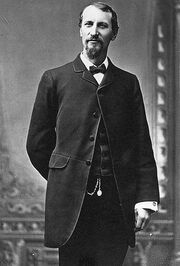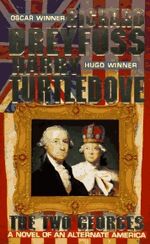No edit summary |
GusF (Message Wall | contribs) No edit summary |
||
| Line 11: | Line 11: | ||
|type of appearance = Posthumous reference |
|type of appearance = Posthumous reference |
||
|death = {{DeathUnknownFictional|Unrevealed}} |
|death = {{DeathUnknownFictional|Unrevealed}} |
||
| − | |nationality = {{AlternateNationality|[[North American Union]]}}}}{{Stack end}}'''Frederick Henry Harvey''' (June 27, 1835 – February 9, 1901) was |
+ | |nationality = {{AlternateNationality|[[North American Union]]}}}}{{Stack end}}'''Frederick Henry Harvey''' (June 27, 1835 – February 9, 1901) was a [[British]]-born [[American]] entrepreneur who developed the Harvey House lunch rooms, restaurants, souvenir shops, and hotels, which served rail passengers on the Atchison, Topeka and Santa Fe Railway, the Gulf Coast and Santa Fe Railway, the [[Kansas]] Pacific Railway, the [[St. Louis]]-[[San Francisco]] Railway, and the Terminal Railroad Association of St. Louis. His partnership with the Santa Fe began in 1876 after a failed 3 year business venture with another partner. At its peak, there were 84 Harvey Houses, all of which catered to wealthy and middle-class visitors alike. They continued to be built and operated into the 1960s. Harvey was the head of the Fred Harvey Company, which operated the hotel and restaurant chain under the leadership of his sons and grandson Nick Harvey until 1968 when it was sold to the [[Hawaii]]-based conglomerate Amfac, Inc. |
==Fred Harvey in ''[[The Two Georges (novel)|The Two Georges]]''== |
==Fred Harvey in ''[[The Two Georges (novel)|The Two Georges]]''== |
||
Latest revision as of 21:56, 18 August 2020
| ||||||||||||||||||||||||||||||
Frederick Henry Harvey (June 27, 1835 – February 9, 1901) was a British-born American entrepreneur who developed the Harvey House lunch rooms, restaurants, souvenir shops, and hotels, which served rail passengers on the Atchison, Topeka and Santa Fe Railway, the Gulf Coast and Santa Fe Railway, the Kansas Pacific Railway, the St. Louis-San Francisco Railway, and the Terminal Railroad Association of St. Louis. His partnership with the Santa Fe began in 1876 after a failed 3 year business venture with another partner. At its peak, there were 84 Harvey Houses, all of which catered to wealthy and middle-class visitors alike. They continued to be built and operated into the 1960s. Harvey was the head of the Fred Harvey Company, which operated the hotel and restaurant chain under the leadership of his sons and grandson Nick Harvey until 1968 when it was sold to the Hawaii-based conglomerate Amfac, Inc.
Fred Harvey in The Two Georges[]
Fred Harvey and his sons continued to expand their business from railroads to airships while maintaining quality. By the end of the 20th century, Fred Harvey gourmet food service had become as much a selling feature as had the fast, efficient service provided by liners of the sky such as the Upper California Limited.[1]
See also[]
- References to Historical Figures in Turtledove's Work, for additional references.
References[]
- ↑ The Two Georges, Ch. 1.
| |||||||||||||||||||||||||

